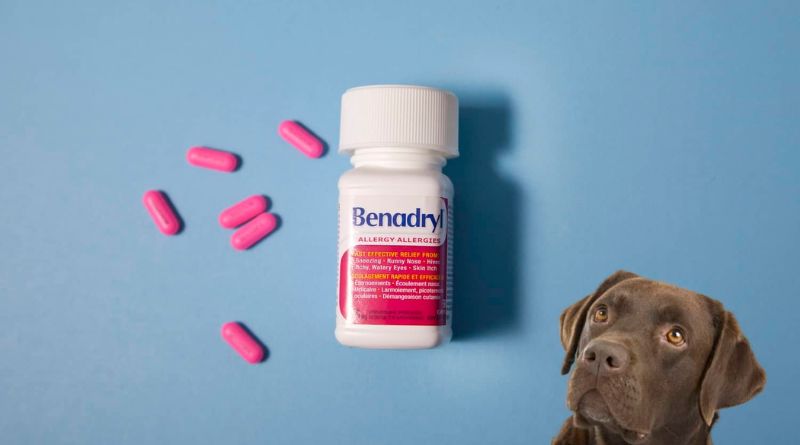Benadryl, the brand name for the drug diphenhydramine, is a commonly used over-the-counter medication that can help alleviate allergy symptoms in both humans and pets. While Benadryl is generally considered safe for dogs, it’s important for pet owners to know the correct dosage and potential side effects before administering it to their pets. This guide will help answer common questions, particularly focusing on the dosage for a 50-pound dog.
Table of Contents
What Is Benadryl and Why Do Dogs Take It?
Benadryl is an antihistamine that works by blocking the histamine receptors in the body, reducing allergic reactions like itching, swelling, sneezing, and rashes. It’s commonly used for managing allergies, insect bites, and reactions to vaccinations in dogs. Benadryl can also be used to treat symptoms of motion sickness or anxiety in some pets.
However, before giving Benadryl to your dog, it’s important to consult your veterinarian, as not all conditions require or respond to this medication, and some dogs may have health conditions that make Benadryl unsuitable.
Common Uses of Benadryl for Dogs:
- Allergic reactions: Including food allergies, seasonal allergies, or reactions to insect stings and bites.
- Motion sickness: Helping dogs who experience nausea or vomiting during travel.
- Anxiety: Sometimes prescribed for dogs with separation anxiety or stress.
Determining the Correct Dosage of Benadryl for a 50 lb Dog
When administering Benadryl to your dog, the general guideline is to give 1 mg of Benadryl per pound of body weight. For a 50 lb dog, this means the correct dosage would be approximately 50 mg of Benadryl.
Standard Dosage Guidelines:
- 1 mg per pound of body weight.
- For a 50 lb dog, the recommended dose would be 50 mg.
Benadryl is available in several forms, including tablets, capsules, liquid, and chewable tablets. The most common form for dogs is the tablet or capsule, but liquid forms should also be used with caution to avoid any accidental overdoses.
Important: Never assume that all Benadryl products are the same. Check the label of the specific product you are using to ensure it contains diphenhydramine without any added ingredients like acetaminophen or alcohol, which can be toxic to dogs.
How to Administer Benadryl to Your Dog
1. Tablets or Capsules:
For dogs, tablets are often the easiest form of Benadryl to administer. If the tablet is too large, you can split it in half. A 25 mg tablet can be given to a 25 lb dog, while a 50 lb dog would likely need two 25 mg tablets or one 50 mg tablet.
2. Liquid Form:
Liquid Benadryl is sometimes easier to give to dogs who are hesitant to take pills. You can use a syringe (without the needle) to measure out the exact dosage. However, be careful when choosing liquid Benadryl to avoid formulations with alcohol or other ingredients that are harmful to dogs.
3. Chewables:
Some dog-friendly Benadryl products are chewable, making them convenient for pets who enjoy treats. Just ensure you calculate the correct amount of Benadryl based on your dog’s weight.
Potential Side Effects of Benadryl for Dogs
While Benadryl is generally safe when given at the correct dosage, it can cause side effects in some dogs. These side effects may vary depending on the dog’s size, age, and overall health. Some dogs may be more sensitive to the drug than others.
Common Side Effects:
- Drowsiness: This is the most common side effect, and in some dogs, it may be pronounced. Benadryl can cause sedation, which might be helpful for dogs with anxiety or motion sickness, but it can also make them lethargic.
- Dry Mouth: Dogs may experience a dry mouth, which may make them drink more water than usual.
- Urinary Retention: Some dogs may have difficulty urinating after taking Benadryl.
- Increased Heart Rate: In rare cases, Benadryl can cause an increase in heart rate or irregular heartbeats.
- Vomiting or Diarrhea: Gastrointestinal upset can sometimes occur, especially if the dog’s stomach is sensitive.
Rare Side Effects:
- Allergic reactions: Although rare, some dogs can develop an allergic reaction to Benadryl, leading to symptoms like swelling, hives, or difficulty breathing. If you notice these signs, seek veterinary attention immediately.
- Overdose: An overdose of Benadryl can lead to more severe side effects, including excessive drowsiness, tremors, seizures, or difficulty breathing. If you suspect your dog has taken too much, contact a veterinarian immediately.
How Often Can I Give Benadryl to My Dog?
For most dogs, Benadryl can be administered every 8 to 12 hours depending on the severity of their symptoms and your veterinarian’s recommendations. It’s important to avoid over-administering Benadryl, as doing so can lead to overdose and serious health complications.
If your dog requires frequent doses, or if the condition persists for an extended period, consult your vet. Long-term use of Benadryl may not be safe for dogs, and your veterinarian may recommend alternative treatments.
When Should You Not Give Benadryl to Your Dog?
While Benadryl is a safe and effective medication for many dogs, there are certain situations in which you should not administer it:
- Pregnancy and nursing: Pregnant or lactating dogs should avoid taking Benadryl unless prescribed by a vet.
- Pre-existing health conditions: Dogs with certain conditions, such as heart disease, glaucoma, high blood pressure, or seizures, may be at risk of adverse reactions. Always consult your vet before giving Benadryl to a dog with underlying health issues.
- Drug interactions: Benadryl can interact with certain medications, so it’s important to ensure there are no contraindications with other treatments your dog may be taking.
When to Seek Veterinary Help
If your dog is experiencing severe allergic reactions, or if symptoms do not improve with Benadryl treatment, seek veterinary care. Additionally, if you suspect your dog has ingested too much Benadryl, it is critical to contact a veterinarian immediately to prevent potentially serious side effects.
Signs That You Should Call the Vet:
- Severe drowsiness or lethargy that does not wear off after a few hours.
- Difficulty breathing, panting excessively, or a noticeable increase in heart rate.
- Tremors or seizures.
- Swelling of the face, lips, or throat indicating an allergic reaction.
FAQs About Giving Benadryl to Dogs
1. Can I give my dog human Benadryl?
Yes, you can give your dog human Benadryl, but make sure it only contains diphenhydramine without additional ingredients. Avoid Benadryl products that contain acetaminophen, decongestants, or alcohol, as these can be harmful to dogs.
2. Is it safe to give Benadryl to puppies?
It is generally safe to give Benadryl to puppies, but you should always consult a veterinarian first. The dosage is typically based on weight, and puppies may require lower doses. Additionally, some puppies may have underlying health conditions that could affect their ability to safely take Benadryl.
3. How do I know if my dog has an allergy?
Signs of allergies in dogs may include itching, scratching, ear infections, watery eyes, sneezing, and gastrointestinal upset. If your dog is experiencing severe or chronic symptoms, consult your veterinarian for an accurate diagnosis.
4. Can Benadryl make my dog sleepy?
Yes, drowsiness is a common side effect of Benadryl. While some owners use this effect to help manage their dog’s anxiety or motion sickness, it’s important to monitor your dog to ensure they’re not too sedated.
5. How long does it take for Benadryl to work in dogs?
Benadryl typically starts working within 30 minutes to 1 hour after administration. However, the full effects may not be seen for up to 2 hours, depending on the individual dog’s metabolism and the severity of their symptoms.
6. What should I do if my dog is allergic to Benadryl?
If your dog shows signs of an allergic reaction to Benadryl, such as swelling, hives, or difficulty breathing, stop administering the medication immediately and seek emergency veterinary care.
Conclusion
Benadryl can be a safe and effective treatment for managing allergies, anxiety, and other conditions in dogs, including a 50 lb dog. The correct dosage is generally 1 mg of Benadryl per pound of body weight, so a 50 lb dog should receive 50 mg. However, before giving your dog any medication, it’s always a good idea to consult with a veterinarian to ensure it’s the right treatment for your dog’s specific needs.
When used appropriately and in the correct dosage, Benadryl can help improve your dog’s quality of life by alleviating allergy symptoms, anxiety, or nausea. Always be mindful of potential side effects and watch your dog closely after administering the medication. If in doubt, contact your vet to ensure that your furry friend stays healthy and safe.









Leave a Reply